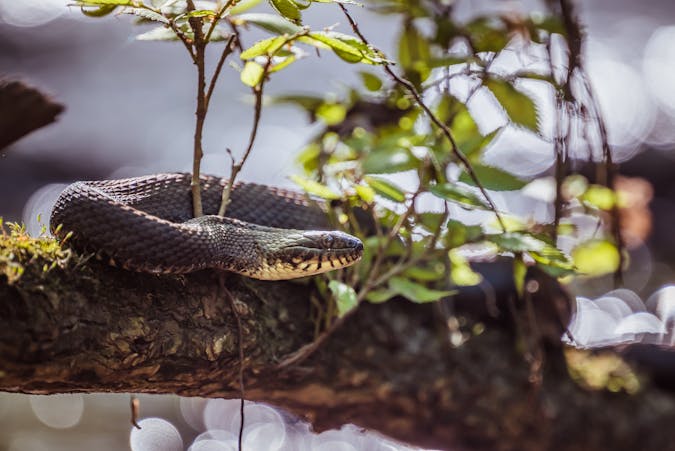
Australia seems to have attracted some of the most dangerous animals in the world and has its fair share of venomous snakes. Having said this, I have only seen snakes on a hike on three occassions and in two instances they were non venomous pythons. Interested in knowing the top 10 deadliest snakes in the world? Here’s the list.
Snakes are generally non-aggressive and mostly attack if provoked or hurt. In fact, most snake bites occur when humans try to capture or kill a snake. Usually, snakes will hear you coming first and slither away but if you do meet one on a hike, don’t approach it but calmly walk the other way.
Any snake bite should be treated as life threatening and knowing poisonous snake bite first aid is imperative. Let’s hope you don’t have to use it.
Immediate Actions to Take After a Snake Bite
Being familiar with snake bite first aid along with having an adequate first aid kit with bandages are prerequesites for hiking in snake habitats. Here are the steps you shoulkd take to treagt a snake bite victim.
Immediate Snake Bite Treatment
- Ensure the patients safety getting them away from the snake if necessary.
- Steps to call for emergency assistance, in Australia we dial 000, in the USA its 911
- Keep your patient still and calm, they must not move
- Lay the casualty down, rest and reassure them.
- If the bite is on a limb, apply a large pressure bandage over the wound.
- Then apply an elastic or firm bandage from the fingers or toes upward, without cutting off blood flow.
- Put a splint on the limb, making sure to include joints near the bite site.
- Document the time of the bite and when the bandage was applied.
- If your patient becomes unconscious or stops breathing apply CPR or defibrillation.
- Remove jewelry, watches, or tight clothing before swelling starts.
What Not to Do
- Do not wash venom off the skin as it could help identify the snake.
- Do not cut the bite area or suck out the venom which can increase the risk of infection and spread the venom further into the body.
- Do not use a tourniquet which can restrict blood flow too severely, causing tissue damage or limb loss. It can also cause the venom to concentrate and damage surrounding tissues.
- Do not try to catch or kill the snake, you could become another victim.
- Do not drink caffeine or alcohol which can exacerbate symptoms and potentially interact negatively with medications or treatments given for snakebite.
- Do not take pain relievers like Asprin or Ibuprofen as they can increase the risk of bleeding and complicate medical treatment.
What are the Signs and Symptoms of a Snake Bite?
Knowing what to look for can assist you in understanding the severity of the bite and help medical professionals with the appropriate treatment. These symptons may appear with an hour and quicker in children.
- Paired fang marks, sometimes only a single mark or scratch, which may bleed.
- Severe pain, swelling, and bruising at the bite site, which may spread up the limb.
- Increased salivation, sweating, numbness, or tingling around the face and limbs.
- Nausea, vomiting, diarrhea.
- Headache, drowsiness, dizziness, or faintness.
- Double or blurred vision, drooping eyelids.
- Voice changes, trouble speaking or swallowing.
- Pain or tightness in the throat, chest, or abdomen.
- Muscle twitching.
- Breathing difficulties, respiratory weakness, or arrest.
Prevention and Care when Hiking
Preventing snake bites involves a combination of awareness, preparation, and cautious behavior. Wearing appropriate clothing such as thick, long pants and gaiters to shield your legs from potential snake encounters. Sturdy boots are essential, as they provide an additional layer of protection.
Avoid tall grass or dense underbrush where snakes may be hiding. Make noise by talking or stomping as you walk; this can alert snakes to your presence and encourage them to move away. Be especially cautious at dusk and dawn, when snakes are most active. If you encounter a snake, remain calm and back away slowly—never attempt to touch or capture it, that’s when your are likely to get bitten! Additionally, familiarize yourself with local snake species and their habitats, and carryinga first aid kit that includes a pressure bandage for emergency situations is a must. If you follow these preventive measures, you can significantly reduce the risk of snake bites and ensure a safer hiking experience. Though it really is quite uncommon to even see a snake when hiking but anything is possible and being prepared is essential. Happy hiking!
Have you had any snake encounters? I’d love to hear them or help with any questions.

This is such a well-rounded guide on snake safety during hikes, and I appreciate how practical and detailed your advice is! It’s true that snakes are generally non-aggressive and would rather avoid us than engage. Your note on prevention, like wearing the right gear and being cautious in certain areas, is great advice. It’s reassuring to hear that encountering snakes on a hike is relatively rare, but being prepared definitely brings peace of mind.
I’ve only had a few encounters myself, but they’ve always ended peacefully by just giving the snake its space. This post is a great reminder that with the right knowledge and a calm approach, we can enjoy our hikes without too much worry about these slithery trail mates. Thanks for sharing!